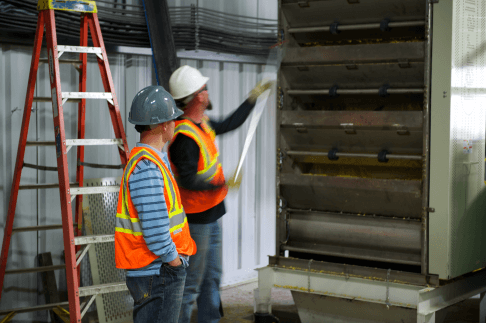When producing feed for your animals, there are two ways to grind your ingredients to create the perfect feed mix quality: pre-grinding and post-grinding. Pre-grinding means grinding up individual ingredients before you mix them together. Post-grinding means grinding up these ingredients after they’ve already been mixed together. As you might imagine, when you choose to grind can have a major effect on the overall quality of your grinding processes. Let’s talk about the key differences between these two types of grain mills, so you can choose the right one for your business.
BENEFITS OF PRE-GRINDING
You may decide to grind up all your ingredients before mixing them together to save time during the production process. You can grind up your ingredients individually the night before, so that everything is ready the next morning when you come into work. Pre-grinding is like getting your ingredients ready the night before when you’re about to make a home-cooked meal. All you have to do is mix them together and the feed will be ready to go.
Pre-grinding will help you make the most of your equipment instead of letting it sit idle for hours on end. Staff members can work the late shift, so you won’t need as many workers on site the next day. This may come in handy if you need to limit facility occupancy due to the coronavirus. If your facility produces large volumes of feed, you can produce more product in less time with pre-grinding.
You’ll want to grind up your ingredients beforehand when using integrated plants in a few recipes. If your facility produces lots of different kinds of feed, keeping track of all your pre-ground materials can be a challenge. Pre-grinding is the best choice for facilities that produce the same kind of feed day in and day out.
DISADVANTAGES OF PRE-GRINDING
Pre-grinding may not be the best choice for your facility if you don’t have a lot of storage space and materials. When grinding up your ingredients the day or night before, you will need to store them in large containers until they are ready to be mixed. This will increase your storage and real estate costs. You may need to invest in a series of industrial bulk containers. You will also have to spend money transporting and loading your pre-ground ingredients, which may delay aspects of your supply chain.
BENEFITS OF POST-GRINDING
Grinding up your materials after they have been mixed together will help your business stay flexible and agile in today’s competitive industry. You won’t have to worry about storing large volumes of pre-ground ingredients overnight, thus helping you make the most of the space in your facility. You also won’t have to invest in a fleet of new containers and lift trucks. If you are short on staff members, storage containers, or real estate space, post-grinding is likely the best choice for your business.
Post-mill grinding will also help you better regulate various grinding processes. When you grind your ingredients individually, some ingredients may be finer or smoother than others. The grain size may not be uniform after these ingredients have been mixed together. You may have to grind up the final batch to address these inconsistencies.
Remember that certain animals can be extremely sensitive to non-uniform particles. Chickens have sensitive digestive systems, which require just the right sized particles.
When you grind up all your ingredients at the same time, you won’t have to worry as much about the size of your particles. There’s a good chance everything will come out of the grinder with the same size and shape.
Post-grinding is also perfect for facilities that process lots of different kinds of feed. You don’t want to spend the money storing lots of different pre-ground ingredients if you tend to follow a different recipe every day. Some of your ingredients may sit on the sidelines for days or weeks if demand for your products tends to change on a dime.
DISADVANTAGES OF POST-GRINDING
The biggest downside to post-mill grinding is that your overall capacity depends on your mixing capacity. You must mix all your ingredients together before grinding them up, so you will have to wait for each batch to mix before moving it onto the next stage of the production process.
If your facility has a limited mixing capacity, you may be better off with pre-grinding.
MAKING THE RIGHT CHOICE FOR YOUR BUSINESS
The feed mixing process within grain mills are all different and choosing between pre- and post-grinding depends on the nature of your business and its products. Consider the types of ingredients used in the mixing process, your overall mixing capacity, and how many different types of feed you tend to produce in a given day. If you need help with feed processing, learn how to determine the feed mix formula.
Keep these tips in mind to improve the mill grinding and mixing process as much as possible. If you’re looking to improve the mixing process, the Buhler Speedmixer can mix a variety of ingredients together in just 90 seconds. It can even process batches at just 10% capacity to keep your facility flexible. With worry-free cleaning and maintenance, it will also help you reduce the chances of cross-contamination.
Visit Halverson Company to learn more about the feed mill construction process and get started on your Salt Lake City construction project today.

